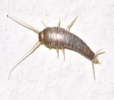
Problems with Silverfish are controllable under professional care. Our treatment goal is to stop a problem at its source so it doesn’t keep coming back. Using state-of-the art equipment and methods, our licensed exterminators will inspect your home’s environment and construction to identify the problem and determine the best course of action. Contact us today!
This insect’s common name comes from its distinctive metallic appearance and fish-like shape.Silverfish and its close cousin, the Firebrat, are nocturnal and hide during the day. If the object they are hiding in is moved, they will dart toward another secluded place.
They come out at night to seek food and water and they prefer dry foods such as cereals, flour, pasta, pet food and also paper with glue or paste. These insects have enzymes in their gut that helps in the digestion of cellulose so they are frequently found in book cases.
Silverfish are considered a pest, due to their consumption and destruction of property. They consume carbohydrates (this includes starches, polysaccharides and dextrin found in adhesives). This means that they will eat glue, book bindings, plaster, some paints, paper, photos, sugar, coffee, hair, carpet, clothing, dandruff, tapestries, cotton, linen, and silks.
These insects can invade homes from surrounding wild areas, especially as these areas dry out during the summer. They also can come in on lumber, wallboard, and similar products.
Silverfish live and develop in damp, warm places, and they prefer areas such as laundry rooms that are 72° to 90°F. If temperatures are higher the relative humidity needs be above 75%. Firebrats thrive best in very warm, dry places with a relative humidity as low as 30% and temperatures above 90°F, with the optimum being 98° to 102°F. However, they can survive at temperatures ranging from freezing to well above 100°F.
Firebrats can be found around ovens, heating units, fireplaces, hot water pipes, attics during the summer, and the furnaces during winter. In apartments and homes, this insect crawls along pipelines and through openings in walls or floors from one level to another. At times, these pests can be found in a bathtub or sink, since they won’t be able to climb out the slippery sides after they fall in.
The common Silverfish is a shiny silver or pearl gray, and about 1/2 to ¾ inch long. In comparison, the common firebrat is shiny and spotted gray or brown, and about 1/2 inch long. Adults of both species are slender, wingless, soft-bodied insects with 2 long, slender antennae. Both of their bodies taper gradually from front to rear to 3 long, thin, tail like appendages.
Females lay eggs in crevices, on cloth, or buried in food or dust. A typical clutch contains 50 eggs, but can vary from 1 to 200. Firebrat eggs hatch in about 2 weeks and silverfish eggs in about 3 to 4 weeks. The rate of development will vary depending on the temperature, humidity, and food sources.
With temperatures below 50°F, a firebrat can take as long as 300 days and silverfish as long as 500 days to develop into adults. In contrast with a temperature above 75°F, it can take firebrats as few as 40 day and silverfish as little as 60 days to develop into adults. Firebrats live about 2 years and silverfish about 3 years
Insecticides by themselves won’t be effective unless you also remove the moisture, food, and hiding places that allow these pests to thrive.
To prevent silverfish and firebrat infestations, keep basements, laundry rooms, and bathrooms-especially shower stalls-clean and dry. Household dust and debris are important sources of food, so routine cleaning will help provide effective control. In addition, periodically clean out closets, cabinets, and storage containers. Patch holes or spaces around pipes and conduits, and repair leaks and drips in plumbing.
Silverfish require a lot of moisture, so using dehumidifiers in closed spaces can help discourage these pests. Ventilation from fans can reduce relative humidity to a point that is intolerable to silverfish. Because collections of magazines, papers, and books provide food and harborage, occasionally move these items around in your bookcase. Keep food in containers with tight lids, especially dry, processed items.